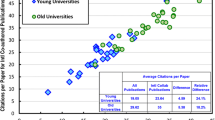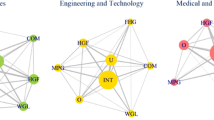Abstract
The importance of collaborations between research institutions in producing highly-cited publications is well documented in the scientometric literature. To avoid a double-counting of these publications at the institutional level, the fractional counting of article authorship is necessary. In this study, the effect of fractional counting on the number of publications from 1212 universities is examined at three levels of citation impact. Alongside an increase in publications over the decade from 2006–2009 to 2016–2019, increasing rates of inter-institutional collaboration are found to increase the division of citation impact being attributed to each collaborating university. This trend is strongly expressed by most major universities and suggests that the structure of research is evolving towards a highly networked model of production in which authorship, and therefore citation impact, is highly dispersed. The growing differences in the fractionalization of publications at different levels of citation impact suggests a divergence in the structure of science. The implications for university rankings in an environment in which research impact is broadly dispersed among many collaborating institutions are discussed.



Similar content being viewed by others
References
Abramo, G., D’Angelo, C. A., & Di Costa, F. (2018). Research collaboration and productivity: Is there correlation? Higher Education, 57(2), 155–171. https://doi.org/10.1007/s10734-008-9139-z
Adams, J. (2013). Collaborations: The fourth age of research. Nature. Nature Publishing Group. https://doi.org/10.1038/497557a.
Adams, J. (2012). Collaborations: The rise of research networks. Nature, 490(7420), 335–336.
Aksnes, D. W. (2003). Characteristics of highly cited papers. Research Evaluation, 12(3), 159–170. https://doi.org/10.3152/147154403781776645
Aksnes, D. W., Schneider, J. W., & Gunnarsson, M. (2012). Ranking national research systems by citation indicators. A comparative analysis using whole and fractionalised counting methods. Journal of Informetrics, 6(1), 36–43.
An, J. Y., Marchalik, R. J., Sherrer, R. L., Baiocco, J. A., & Rais-Bahrami, S. (2020). Authorship growth in contemporary medical literature. SAGE Open Medicine, 8, 205031212091539. https://doi.org/10.1177/2050312120915399
de Solla Price, D. J. (1975). Science since Babylon. Yale University Press. Price, Derek J.
Debackere, K., Aronld, E. Siversten, G. Spaapen, J., & Sturn, D. (2018). Performance-based funding of university research. Luxembourg: European Union.
Debackere, K., & Glänzel, W. (2004). Using a bibliometric approach to support research policy making: The case of the Flemish BOF-key. Scientometrics, 59(2), 253–276.
Gauffriau, M., & Larsen, P. O. (2005). Counting methods are decisive for rankings based on publication and citation studies. Scientometrics, 64(1), 85–93. https://doi.org/10.1007/s11192-005-0239-6
Katz, J. S., & Hicks, D. (1997). How much is a collaboration worth? A calibrated bibliometric model. Scientometrics, 40(3), 541–554. https://doi.org/10.1007/BF02459299
Larivière, V., Gingras, Y., Sugimoto, C. R., & Tsou, A. (2015). Team size matters: Collaboration and scientific impact since 1900. Journal of the Association for Information Science and Technology, 66(7), 1323–1332. https://doi.org/10.1002/asi.23266
Lin, C. S., Huang, M. H., & Chen, D. Y. (2013). The influences of counting methods on university rankings based on paper count and citation count. Journal of Informetrics. https://doi.org/10.1016/j.joi.2013.03.007
Neijssel, Mark (2021) Personal communication, e-mail. 28 June, 2021.
Papatheodorou, S. I., Trikalinos, T. A., & Ioannidis, J. P. A. (2008). Inflated numbers of authors over time have not been just due to increasing research complexity. Journal of Clinical Epidemiology, 61(6), 546–551. https://doi.org/10.1016/j.jclinepi.2007.07.017
Potter, R. W. K., Szomszor, M., & Adams, J. (2020). Interpreting CNCIs on a country-scale: The effect of domestic and international collaboration type. Journal of Informetrics. https://doi.org/10.1016/j.joi.2020.101075
Pritychenko, B. (2016). Fractional authorship in nuclear physics. Scientometrics, 106(1), 461–468. https://doi.org/10.1007/s11192-015-1766-4
R Core Team (2020). R: A language and environment for statistical computing. R Foundation for Statistical Computing, Vienna, Austria. https://www.R-project.org/.
Sivertsen, G. (2016). Publication-based funding: The Norweigan Model. In M. Ochsner. S.E. Hug & H. D. Daniel (Eds.) Research assessment in the humanities: Towards criteria and procedures (pp. 79–90). Zürich: Springer Open.
Sivertsen, G., Rousseau, R., & Zhang, L. (2019). Measuring scientific contributions with modified fractional counting. Journal of Informetrics, 13(2), 679–694.
Solla, P., & Derek, J. (1963). Little science, big science. New York: Columbia University Press.
Waltman, L., Calero-Medina, C., Kosten, J., Noyons, E. C. M., Tijssen, R. J. W., Van Eck, N. J., Van Leeuwen, T. N., Van Raan, A. F. J., Visser, M. S., & Wouters, P. (2012). The Leiden ranking 2011/2012: Data collection, indicators, and interpretation. Journal of the American Society for Information Science and Technology, 63(12), 2419–2432. https://doi.org/10.1002/asi.22708
Waltman, L., & van Eck, N. J. (2015). Field-normalized citation impact indicators and the choice of an appropriate counting method. Journal of Informetrics, 9(4), 872–894. https://doi.org/10.1016/j.joi.2015.08.001
Wuchty, S., Jones, B.F., & Uzzi, B. (2007). ‘The Increasing Dominance of Teams in Production of Knowledge’. Science 316, no. 5827: 1036 LP – 1039.
Author information
Authors and Affiliations
Corresponding author
Ethics declarations
Conflict of interest
The author declares that they have no conflict of interest.
Rights and permissions
About this article
Cite this article
Demaine, J. Fractionalization of research impact reveals global trends in university collaboration. Scientometrics 127, 2235–2247 (2022). https://doi.org/10.1007/s11192-021-04246-w
Received:
Accepted:
Published:
Issue Date:
DOI: https://doi.org/10.1007/s11192-021-04246-w




